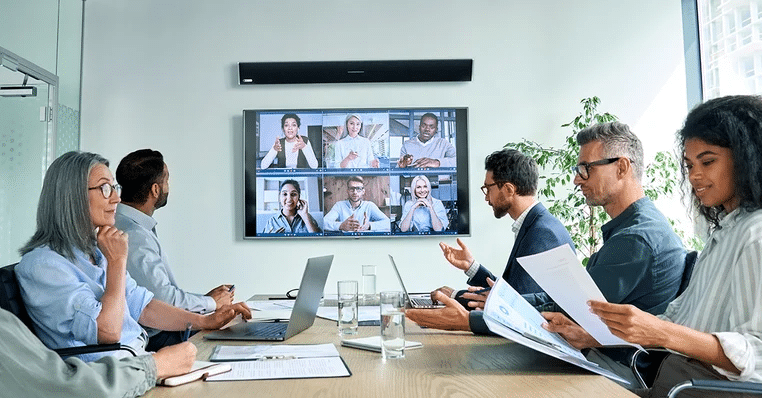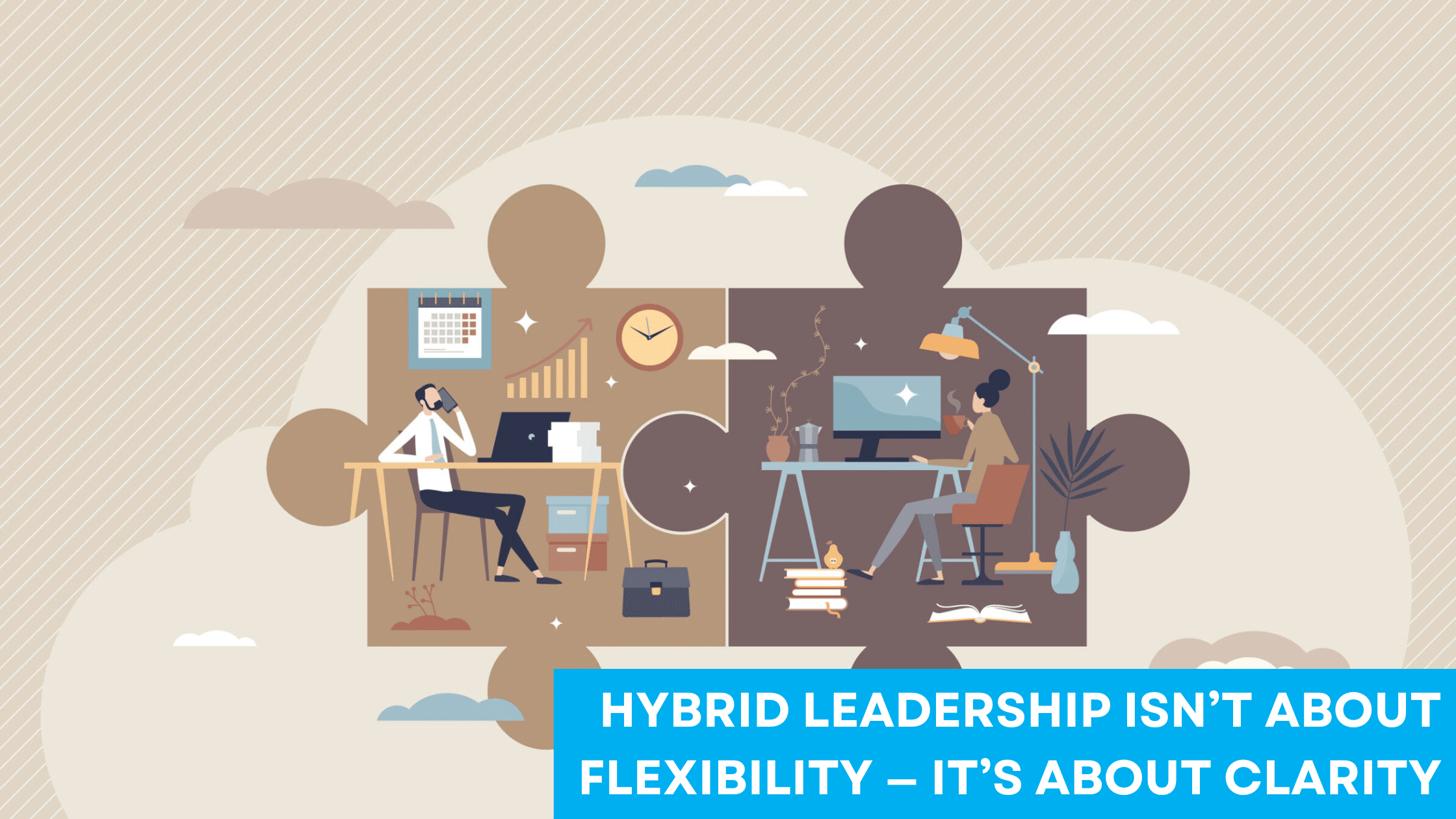The shift to hybrid work has transformed how teams operate, blending in-office and remote work environments.
Building and leading high-performing hybrid teams requires a strategic approach to communication and engagement.
Successful teams combine the flexibility of remote work with the collaboration and innovation fostered in an office setting.
To navigate these challenges, leaders must cultivate a strong team culture and employ technologies that facilitate seamless collaboration.
Local leaders can bolster team cohesion through regular events and bonding moments, ensuring everyone feels included regardless of their physical location.
A future-focused vision helps companies align their hybrid teams with broader strategic goals.
The COVID-19 pandemic accelerated the adoption of hybrid work models, prompting organizations to rethink traditional management practices.
With the right tools and mindset, leaders can harness the benefits of hybrid work to create dynamic, adaptable teams poised to excel in any environment.
The Evolving Concept of Work
The shift from traditional office environments to hybrid work models has transformed organizations’ functions.
Key changes stem from the COVID-19 pandemic, which accelerated the adoption of remote work and increased the demand for flexible work arrangements.
From Traditional to Hybrid: The Impact of COVID-19
The traditional work model, centered around physical office spaces, was significantly disrupted by the COVID-19 pandemic.
Suddenly, many organizations needed to transition to remote work to ensure business continuity and employee safety. This swift change highlighted the necessity for digital transformation and reshaped work dynamics.
Remote work offered unprecedented flexibility, allowing employees to balance personal and professional responsibilities more effectively.
Despite initial challenges, many companies observed sustained or improved productivity levels. This positive outcome prompted leaders to consider hybrid work models as a permanent solution rather than a temporary fix.
The hybrid model blends onsite and remote work, enabling organizations to maintain the benefits of face-to-face collaboration while providing employees with the flexibility to work from home.
It also reduced overhead costs, such as office space expenses, fostering long-term financial sustainability.
Defining Hybrid Work and Its Core Components
Hybrid work incorporates remote work and in-office activities, creating a flexible work environment tailored to diverse needs.
Key components of hybrid work include:
- Flexibility: Employees can choose where and when to work, supporting a better work-life balance.
- Technology: Robust digital tools and platforms are essential for seamless communication and collaboration.
- Adaptability: Organizations must be prepared to adjust strategies and policies as circumstances change.
- Inclusivity: Ensuring all team members feel valued and included in the company culture regardless of location.
This model requires leaders to cultivate a trust-based culture, focusing on outcomes rather than physical presence.
As a result, hybrid work can enhance productivity, job satisfaction, and talent retention, positioning companies for future success.
Building Blocks of High-Performing Hybrid Teams
Creating high-performing hybrid teams requires focusing on specific characteristics that facilitate collaboration, communication, and clear role definition.
Effective leadership in hybrid teams promotes trust and ensures all members are aligned with their roles and expectations.
Characteristics of Hybrid Teams
Hybrid teams blend in-office and remote work, allowing flexibility while maintaining productivity.
A key characteristic is effective communication within the team.
Utilizing digital communication tools ensures that all team members are connected and engaged regardless of their location.
Building trust is essential. Leaders should foster a culture of transparency and accountability.
Regular check-ins and updates help maintain trust and ensure everyone is on the same page.
Another vital characteristic is adaptability.
Hybrid teams must be able to pivot and adjust to new situations quickly.
Incorporating agile methodologies can assist in achieving this adaptability by streamlining processes and increasing efficiency.
Implementing Clear Roles and Expectations
Clear roles and expectations are fundamental for hybrid teams.
Leaders must set well-defined roles for each team member, detailing their responsibilities and expectations. This clarity helps in minimizing confusion and overlaps in duties.
For example, a leader might outline that a specific team member is responsible for data analysis and reporting while another handles client communication.
Developing daily rituals and rules of engagement enhances team cohesion.
Regular virtual meetings, status updates, and documented workflows ensure a consistent task approach.
Providing clear guidelines on reporting and action steps can significantly improve productivity.
For instance, implementing the five levels of authority helps team members understand when to act independently and when to seek approval, promoting efficiency and autonomy.

Leadership in a Hybrid Environment
Effective leadership in a hybrid environment involves adapting to new dynamics, promoting engagement, and fostering a supportive culture.
Leaders and executives are critical in guiding their teams through these changes, ensuring all members feel connected and valued.
The Role of Leaders and Executives
Leaders and executives are pivotal in setting the tone for a hybrid workplace.
They must balance remote and in-person interactions, ensuring neither group feels marginalized. Clear communication is essential.
Regular updates and clear expectations help maintain alignment.
Leaders can leverage interactive tools like chat, polls, and informal competitions to keep team members engaged during meetings.
Empathy and emotional intelligence are crucial.
Leaders should be attentive to their team members’ mental and emotional well-being.
They can build stronger, more resilient teams by acknowledging and addressing individual needs.
Fostering a Culture of Trust and Support
Building a culture of trust is fundamental in a hybrid environment.
Trust is built through transparency, consistent communication, and authenticity. Leaders must be open about their decisions and the rationale behind them.
Support mechanisms are also vital.
Providing resources for professional development and creating opportunities for team bonding can help cultivate a supportive environment.
Leaders should encourage feedback and be responsive to it.
Mental health support is another key area.
Leaders should promote a healthy work-life balance and proactively address any signs of burnout or stress.
Recognizing and celebrating achievements, no matter how small, can also boost morale and foster a sense of community.
Effective Communication and Collaboration
Effective communication and collaboration are the backbones of successful hybrid teams.
Choosing appropriate communication channels and fostering an environment where collaboration thrives despite geographical distances is vital.
Choosing the Right Communication Channels
Selecting the appropriate communication tools is crucial.
Email is useful for formal communications or information that does not require immediate feedback. For urgent matters, instant messaging tools like Slack or Microsoft Teams facilitate quick interactions.
Regular team meetings, either virtual or in-person, help ensure everyone is aligned.
Video conferencing platforms such as Zoom or Google Meet allow team members to engage face-to-face, providing a richer interaction experience.
Balancing synchronous and asynchronous communication is key.
Some team members may be in different time zones, making flexibility and inclusion essential.
Encourage using shared documents and collaborative tools like Google Docs or Microsoft OneDrive for team projects.
Promoting Collaboration in a Dispersed Team
In a hybrid setup, fostering collaboration can be challenging.
Leaders should create clear guidelines for collaboration, setting expectations, and defining roles.
Regular check-ins and collaborative meetings help keep the team cohesive.
Utilizing digital collaboration tools such as Trello or Asana can streamline project management.
These tools enable team members to track progress and contribute asynchronously.
Encouraging social interaction also plays a significant role; virtual coffee breaks or team-building activities can enhance camaraderie.
Empowering employees to take initiative and share ideas creates a culture of continuous improvement.
Giving feedback through structured sessions and ad hoc comments fosters a transparent and open environment, essential for effective collaboration.
Strategies for Maximizing Productivity
Efficient team management hinges on setting achievable goals and ensuring team well-being. This involves precisely tracking progress and creating a balance that prevents burnout.
Setting and Tracking Team Goals
Establishing clear, specific, achievable goals is a key strategy for maximizing productivity.
Utilizing SMART (specific, measurable, achievable, relevant, time-bound) criteria can be particularly effective. This ensures each team member knows their responsibilities and can see how their work contributes to the larger objectives.
Incorporate digital tools that track these goals in real-time.
Frequent check-ins help monitor progress and swiftly address roadblocks. Platforms like Trello or Asana can streamline this process, visually representing tasks and timelines.
Regular feedback loops are also critical.
Celebrate milestones and address any issues early to keep the momentum going. This approach fosters a sense of accomplishment and keeps the team aligned with the company’s long-term vision.
Preventing Burnout and Fostering Work-Life Balance
To sustain high productivity levels, preventing burnout is crucial.
Create a manageable workload by prioritizing tasks effectively and ensuring no employee is overwhelmed.
Flexible schedules and remote work options can aid in fostering a better work-life balance.
Encourage regular breaks and time off.
This avoids the pitfalls of continuous work without rest, which can diminish productivity.
Companies can offer wellness programs that include yoga, meditation, or even gym memberships to support mental and physical health.
It is essential to build a supportive environment where employees feel comfortable discussing their workload and stress levels.
Managers should be trained to recognize signs of burnout and take steps to address them proactively.
By maintaining a healthy and balanced team, long-term productivity and employee satisfaction can be secured.
Cultivating Team Culture and Engagement
Building a strong team culture and maintaining high levels of team engagement is critical for the success of hybrid teams. Specific strategies can help instill a shared vision and values while providing methods for measuring and enhancing team engagement.
Instilling a Shared Vision and Values
Creating a shared vision starts with aligning the team’s goals with the organization’s mission.
Project leaders should communicate how individual contributions support the overall objectives. This helps team members understand their roles within the larger picture.
Values play a crucial role in guiding behavior and decision-making.
Leaders can foster these values through regular reinforcement and celebrating behaviors that exemplify them.
Organizing workshops or training sessions to discuss and define core values can also be effective.
It’s essential to maintain consistency across different working environments in hybrid teams.
Leveraging digital tools for consistent communication and holding hybrid meetings can help bridge the gap between remote and in-office employees. Encouraging participation from all members during these meetings ensures everyone feels included.
Measuring and Enhancing Team Engagement
Team engagement must be measured through regular check-ins and surveys.
Metrics such as productivity, participation in team meetings, and feedback from team members provide insights into engagement levels.
Utilizing tools like performance metrics dashboards can help track these indicators effectively.
Enhancing engagement involves acknowledging and addressing the feedback received.
Regular recognition of big and small achievements can significantly boost morale.
Additionally, providing opportunities for professional growth, such as training programs or career development plans, keeps team members motivated.
Encouraging open dialogue is vital.
Platforms for anonymous feedback can help identify issues that might not surface in regular discussions.
Implementing action plans based on this feedback demonstrates that leadership values and acts on team input, further strengthening engagement.
Inclusion and Fairness in a Hybrid Setting
Building inclusive and fair practices in hybrid teams is crucial for equitable treatment between employees working from home and those in the office. Effective leadership practices are key to fostering an inclusive environment.
Ensuring Equity Among Remote and In-Office Employees
Equity between remote and in-office employees can be challenging.
Leaders should ensure both groups have access to the same resources and opportunities. This includes offering equal opportunities for professional development and career advancement.
Consistent communication is vital.
Regular check-ins via video calls can help remote employees feel as involved as their in-office counterparts.
Additionally, sharing digital platforms ensures all team members access the same information.
Leaders should monitor performance metrics and recognition practices to avoid biases favoring in-office employees.
Inclusive Leadership Practices
Inclusive leadership involves recognizing and valuing all team members’ diverse experiences and perspectives.
Leaders can promote inclusion by actively seeking input from both remote and in-office employees.
Creating a psychologically safe environment is essential. This can be achieved by encouraging open dialogue and ensuring employees feel comfortable sharing their opinions without fear of negative repercussions.
Digital tools play a significant role in fostering inclusion. Platforms that support collaboration and communication can bridge physical distances and create a sense of community.
Leaders should also commit to continuous learning around diversity, equity, and inclusion to lead effectively.
By implementing these practices, leaders can build a hybrid team that values inclusion and fairness for all employees, regardless of their working location.
Supporting and Developing Employees
Building and leading high-performing hybrid teams requires specialized support and a focus on employee development.
Critical methods include empowering workers through coaching and professional growth initiatives and tailoring support to each person’s needs.
Empowering Through Coaching and Professional Growth
Effective coaching and opportunities for professional growth are key to fostering high performance.
Managers should conduct regular one-on-one meetings to discuss career goals and provide constructive feedback. This reinforces a continuous learning culture and encourages a growth mindset.
Utilizing tools like performance management software can help track progress and identify areas for improvement.
Access to online training courses, workshops, and mentorship programs encourages skill enhancement.
Encouraging certifications or professional courses relevant to their roles can be beneficial. This not only improves individual performance but also adds value to the organization.
Clear communication of development plans ensures everyone knows the steps involved in achieving their career milestones.
Adapting Support to Individual Needs
Understanding that each employee has unique needs is essential.
Flexible schedules, personalized workload management, and mental health resources can significantly enhance job satisfaction and productivity.
Implementing feedback mechanisms, such as surveys and suggestion boxes, helps identify individual support requirements.
Employers should also promote work-life balance by encouraging regular breaks and flexible working hours.
Managers should show empathy and actively listen to employees’ concerns.
Implementing tailored approaches, such as adjusting work assignments based on skill sets and current workloads, can help prevent burnout.
Recognizing achievements and providing the necessary resources to overcome challenges is important.
Harnessing Creativity and Innovation
In today’s rapidly evolving business landscape, fostering innovation and creativity within hybrid teams is essential. Effective strategies can unlock new opportunities and enhance competitive advantage.
Encouraging Innovative Thinking
To encourage innovative thinking, leaders should create an environment that allows experimentation and the free exchange of ideas.
Providing time and space for team members to brainstorm can lead to breakthrough solutions.
Encouraging a culture where all ideas are valued, even those that might initially seem “bad,” is important for nurturing creativity.
Utilizing diverse perspectives within hybrid teams can lead to more comprehensive and creative outcomes.
Leaders can assess each team member’s innovation aptitude to build a stronger unit, as recommended by McKinsey.
Implementing regular innovation workshops and training sessions can also help maintain a high level of creative thinking across the team.
Leveraging Hybrid Teams for Competitive Advantage
Hybrid teams uniquely combine the strengths of both remote and in-office work environments, paving the way for greater flexibility and innovation.
This structure allows organizations to tap into a global talent pool, bringing diverse ideas and cultural viewpoints to the table, which is crucial for creative problem-solving and developing new value propositions.
High-performing hybrid teams are better equipped to adapt to rapid market changes.
According to Harvard Business Review, giving employees time to ideate can significantly enhance innovation.
Moreover, hybrid teams can leverage various technological tools for collaboration, ensuring seamless communication and productivity, ultimately driving the organization toward innovative and competitive success.
Operational Excellence and Accountability
Building and managing high-performing hybrid teams requires operational excellence and strict accountability. These elements ensure streamlined processes and clear responsibilities, crucial for achieving desired outcomes.
Establishing Effective Workflows
Effective workflows in hybrid teams start with clear communication and shared goals.
Managers can utilize digital tools like project management software to keep track of tasks and deadlines.
Asana and Trello are popular choices that integrate well with remote and on-site work environments.
Regular check-ins and updates help monitor progress and address any roadblocks promptly.
Setting realistic expectations through SMART goals (Specific, Measurable, Achievable, Relevant, Time-bound) provides direction and clarity.
Documenting processes, including step-by-step guidance and best practices, ensures consistency and quality.
Collaborative platforms like Microsoft Teams and Slack facilitate real-time collaboration, making it easier to maintain effective workflows despite geographical barriers.
Maintaining Accountability in a Hybrid Framework
Accountability in hybrid teams hinges on transparency and responsibility.
Leaders should establish clear roles and responsibilities, ensuring each team member knows their tasks and deadlines.
Regular performance reviews and feedback sessions help maintain high standards and boost morale.
Key Performance Indicators (KPIs) and Objectives and Key Results (OKRs) are useful metrics for tracking team performance.
These tools make it easier to identify areas that need improvement and recognize achievements.
Implementing a robust reporting system, where team members report progress routinely, reinforces accountability.
Tools such as Jira or Monday.com can facilitate this.
Fostering a culture of trust and accountability is essential. Celebrate successes and learn from failures to create a resilient and proactive team culture.
Maintaining Resilience and Adaptability
Organizations need to foster resilience and adaptability to thrive in a hybrid workplace. These qualities allow teams to navigate uncertainties and maintain high performance.
Building an Agile Hybrid Workspace
Creating an agile hybrid workspace involves integrating flexibility and technology.
This means enabling employees to switch effortlessly between physical locations and remote environments.
Tools like video conferencing software, cloud storage, and collaboration platforms are essential. They ensure seamless connectivity and communication across the team.
Organizations should encourage a culture of continuous learning.
By implementing frequent training, teams can quickly adapt to new technologies and processes.
Flexible work policies, such as adjustable hours, can cater to individual needs.
This helps employees manage their work-life balance effectively, increasing overall productivity and well-being.
Resilience in the Face of Change
Resilience in hybrid teams is built through strong leadership and supportive structures.
Leaders should show genuine interest in team progress, which fosters trust and transparency.
Encouraging open feedback and reflection helps teams learn from their experiences.
This continuous feedback loop allows for timely adjustments to strategies and behaviors.
A focus on mental health and well-being is crucial.
Providing access to resources like counseling and stress management workshops can help employees navigate challenges more effectively.
Finally, setting clear goals and expectations helps teams stay aligned.
Adapting to changes and overcoming setbacks becomes easier when everyone understands their roles and objectives.



